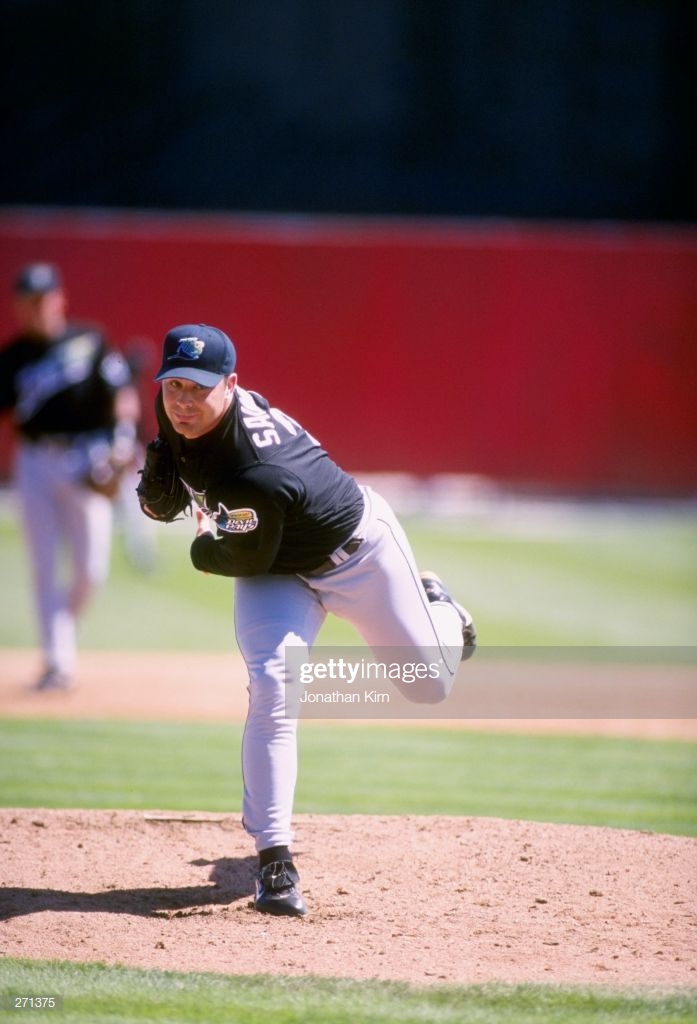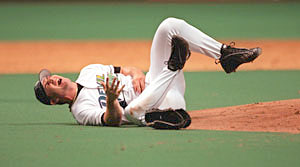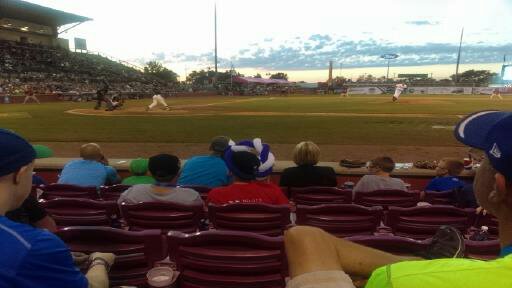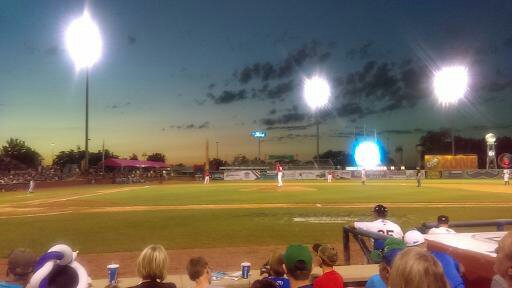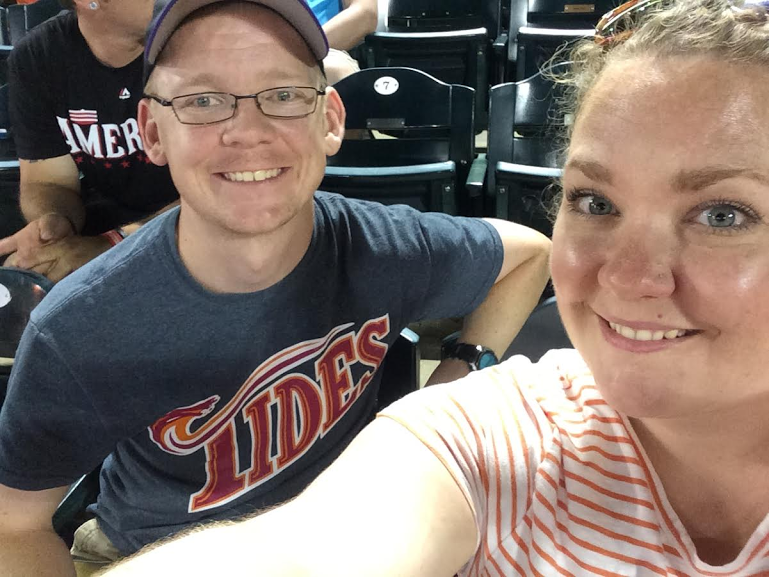Tagged: Single A
Reaching Your Goal
Are you part of the nearly half of New Year’s Resolutioners that have given up? Or are you one of the less than 10% who will be successful? Life is hard, keep working towards your dreams. Ron Wright never gave up. He fought for what he wanted. All of his hard work eventually paid off.
Ron Wright was selected in the 7th Round of the 1994 MLB Draft by the Atlanta Braves from Kamiakin High School in Kennewick, Washington. He played two and a half seasons in the Braves minor league system. Wright spent 1994 with the Rookie Level Gulf Coast League Braves, 1995 with the Single A Macon Braves, and 1996 with the High A Durham Bulls and Double A Greenville Braves before an August trade to the Pittsburgh Pirates. Wright now set his sights on the Steel City. He finished 1996 with the Double A Carolina Mudcats and spent 1997 with the Triple A Calgary Cannons. 1998 was a lost season as Wright appeared in only 20 Games, 17 with the Triple A Nashville Sounds and 3 with the Rookie Level Gulf Coast League Pirates. 1999 was equally frustrating, playing only 24 Games for the Double A Altoona Curve. In October, the Cincinnati Reds selected Wright off waivers. His aim moved further down the Ohio River. Wright spent 2000 with the Double A Chattanooga Lookouts and Triple A Louisville RiverBats. In November, Wright signed as a Minor League free agent with the Tampa Bay Devil Rays. He spent the season back with the Durham Bulls, now a Triple A team. Again a Minor League free agent, Wright signed with the Seattle Mariners for the 2002 season. He began the season with the Triple A Tacoma Rainiers. Ron Wright had played eight Minor League seasons with 12 different teams.
Heading into the 2002 season Wright had played in 666 Minor League games. He hit .261 with 121 Home Runs, 453 RBI, and 361 Runs scored in 2,729 Plate Appearances. Wright had played at every level, Rookie Ball to Triple A. He fought through injuries and the ups and downs of professional baseball. Wright remained one step away from the Majors. The trip from Cheney Stadium to Safeco Field is only 35 miles, but Wright kept fighting to make that drive.
The bad news in Seattle was future Hall of Fame Edgar Martinez was hurt running to First. Martinez’s injury put a damper on the Mariners early season success. Edgar’s injury was bad news for everyone except Minor League journeyman Ron Wright. He finally got the call to the Big Leagues. The years of toil had paid off. He was heading to the show.
It was a pleasant afternoon in Arlington, Texas. It was 76℉ and overcast. Ron Wright had made it to the Majors on Sunday, April 14, 2002. The Mariners were on the road, playing the Rangers at The Ballpark in Arlington. 32,866 fans watched as Seattle’s John Halama faced off against Texas’ Kenny Rogers. Ron Wright was the DH, batting 7th for the Mariners. All was right in the world.
In the Top of the 2nd, Ron Wright strolled to the plate. This was the moment he had worked so hard for, his first Major League At Bat. Ruben Sierra was standing on Second after a lead off Single and a John Olerud Walk. Wright stepped in the Right Handed Batters Box looking to add to the Mariners 1-0 lead. Kenny Rogers rocked and fired. In the blink of an eye, Wright was walking back to the dugout. Striking out looking on three pitches was not how Wright envisioned his first At Bat in the Big Leagues, but he had stamped his name in the record books as playing in a Major League game. There would be more chances.
The next opportunity for Wright came in the Top of the 4th. Seattle still clung to its 1-0 lead, and Wright could extend the lead. He again came up with Sierra and Olerud on base. Sierra led off with a Double and moved to Third on Olerud’s Single. Wright worked the count to 2-2. On the fifth pitch he swung. The ball bounced to Rogers on the mound who fired to Alex Rodriguez coming over from Shortstop to cover Second for the first Out. Rodriguez then threw home to Catcher Bill Haselman who chased Sierra back towards Third. He tossed the ball to Third Baseman Hank Blalock who chased Sierra back towards Home. Blalock tossed the ball to Rogers who tagged Sierra for the second Out. During the rundown Wright reached First and was advancing towards Second. He was never known for his speed, just nine Stolen Bases in the Minors. After tagging Sierra, Rogers threw to Second Baseman Michael Young who tagged Wright coming into Second for the third Out. The 1-6-2-5-1-4 Triple Play killed the rally, and made Wright’s debut memorable for all the wrong reasons.
Baseball is about dealing with failure. There are few failures like hitting into a Triple Play. Baseball does not give you long to dwell on your failures. In the Top of the 6th, Wright came up for the third time. He was patient in his first two At Bats, but not this time. The Mariners were trailing 2-1. Again Ruben Sierra was on Second and John Olerud on First. On the first pitch from Rogers, Wright hit the ball to Shortstop Alex Rodriguez to start a Double Play. Sierra moved to Third, but the rally was dead. The frustrating day continued.
Ron Wright never got that fourth At Bat. Manager Lou Piniella sent up Pinch Hitter Mark McLemore in the 7th Inning. His Major League debut was complete. Wright had three At Bats against Kenny Rogers. He saw nine pitches. Made six Outs. The Mariners won 9-7. The game took 3 hours and 39 minutes. Before the Mariners returned to the field on Monday Ron Wright was back in the Minors. He never returned to the Majors. Wright’s Major League career took less time than it takes to watch Gone With The Wind.
Was it worth it? Despite one of the worst possible debuts, Ron Wright can proudly say he was a Major League Baseball player. Only 18,039 players before him earned that title. While his career was not what he hoped, Wright made it to the top. He kept grinding. He kept going. The baseball gods rewarded his lifetime of work with one of the strangest days ever on a baseball field. Keep working towards your goals.
DJ
What Could Have Been
In 2008 the Tampa Bay Devil Rays dropped the Devil, becoming the Tampa Bay Rays. Changing their name also changed their fortunes. The Rays have a .535 winning percentage, much better than the Devil Rays, .399. Tampa is winning roughly 22 more games a season since the switch. In 12 seasons as the Rays, Tampa Bay has won at least 90 games seven times, made the Postseason five times, won the American League East twice, and reached one World Series. The Rays success has come while averaging 27th in team payroll.
Tropicana Field was not always home to success. The Devil Rays began play in 1998 and struggled through the 2007 season, their last as the Devil Rays. They averaged 25th in payroll, including ranking 10th in 2000. The 2004 season was the Devil Rays best, winning 70 games and did not finish last. Tampa Bay finished 4th, three games ahead of the Toronto Blue Jays.
Every expansion team has growing pains as they build a competitive team. Tampa Bay received no breaks in the Expansion Draft. None of their first five draft picks played more than three seasons in Tampa Bay. Teams need players to build around and the Devil Rays did not find a franchise player in the Expansion Draft.
The Devil Rays held the first overall pick in the 1997 Expansion Draft. Tampa Bay selected Florida Marlins pitcher Tony Saunders. In 1997, the 23 year old lefty started 21 games for the Florida Marlins, going 4-6 with a 4.61 ERA and 1.464 WHIP in 111.1 Innings, allowing 57 Earned Runs, 12 Home Runs, 64 Walks, and 102 Strikeouts. Saunders pitched in the Marlins Postseason run to their World Series victory. Saunders, a young lefty with Postseason experience, was a logical first pick.
The Devil Rays took Tony Saunders with the first overall pick in the 1997 Expansion Draft. (Jonathan Kirn/Allsport/ Getty Images)
The 1998 Tampa Bay Devil Rays struggled, finishing 63-99, 16 games behind the fourth place Baltimore Orioles. In 31 starts, Tony Saunders went 6-15 with a 4.12 ERA and 1.570 WHIP in 192.1 Innings, allowing 88 Earned Runs, 15 Home Runs, 111 Walks (league leader), and 172 Strikeouts. Saunders pitched 7+ innings in 10 starts, allowing 3 runs or less in nine of those starts. He won twice. In four of those starts, Saunders pitched 8 innings, allowing three runs or less, yet he lost all four starts. Saunders received 3.37 in run support, while Major League teams averaged 4.79 runs per game. Tony Saunders pitched well for the expansion Devil Rays, despite his record.
Tampa Bay and Tony Saunders entered the 1999 season full of hope. The Devil Rays sought to play more competitive baseball and Saunders looked to build upon his success. Entering play on May 26th, the Devil Rays were 22-24. An expansion team hovering around .500 a quarter of the way through the season had many hoping the Devil Rays would soon contend. The Texas Rangers were visiting Tropicana Field facing the surprising Devil Rays. In the Top of the Third Inning, the Rangers had runners on first and third with two outs, trailing 3-2. Tony Saunders had a full count on reigning American League MVP Juan Gonzalez. Saunders took the sign from John Flaherty and uncorked a Wild Pitch. Gonzalez trotted to first, Rusty Greer moved to second, and Luis Alicea scampered home to tie the game.
Tropicana Field fell silent except for Tony Saunders screaming, writhing in pain on the ground. The pitch broke the humerus bone, the bone connecting the shoulder and elbow, in Saunders’ left arm. Training staff tried helping Saunders up, but the pain was too much. He was carted off the field and taken to the hospital. His season was finished and his career was in doubt.
Professional baseball players are tough. They play through pain and injury throughout the long season. A year after breaking his arm Tony Saunders was pitching again. His rehab assignment began with the Charleston RiverDogs, Tampa Bay’s Single A team. Saunders pitched in two games, throwing 5 Innings, with a 1.80 ERA and 0.800 WHIP, allowing 2 Hits, 1 Earned Run, 2 Walks, and 3 Strikeouts. He was promoted to the St. Petersburg Devil Rays, Tampa Bay’s Advanced A team. Entering the Third Inning of his second game, Saunders had pitched 7 Innings with a 3.86 ERA and 1.429 WHIP, allowed 7 Hits, 3 Earned Runs, 3 Walks, and 3 Strikeouts. Then it happened again, Saunders broke his arm throwing a pitch. His Major League career was over.
Tony Saunders broke his arm throwing a baseball. The Devil Rays future rested on his left arm. (www.mlb.com)
The Devil Rays retained their rights to Saunders through 2004, when they released him. Less than a month later the Orioles signed Saunders. He pitched in Spring Training for the Orioles, but spent the 2005 season pitching for the Mesa Miners of the independent Golden Baseball League. He pitched 9 Games in relief, going 1-0 with a 1.80 ERA and 1.600 WHIP. He threw 10 Innings, allowed 9 Hits, 2 Earned Runs, 7 Walks, and 8 Strikeouts.
There are no guarantees in baseball. Tony Saunders is not alone in having his career cut short by injuries. However his injuries were particularly gruesome. The future of the Devil Rays rested on his left arm, it took years for Tampa Bay to recover. Tony Saunders’ efforts to continue his baseball career did not go unnoticed. He received the 2000 Tony Conigliaro Award from the Boston Chapter of the Baseball Writer’s Association of America. The annual award is given to a Major League player who best overcomes an obstacle and adversity through the attributes of spirit, determination, and courage. While the award cannot replace his career, it is important to recognize Saunders’ perseverance in his comeback attempts.
Tony Saunders’ final career statistics: 3 Seasons, 61 Games Started, 2 Complete Games, 13 Wins, 24 Losses, 4.56 ERA, 1.528 WHIP, 345.2 Innings Pitched, 343 Hits, 175 Earned Runs, 33 Home Runs, 204 Walks, and 304 Strikeouts.
Oh, what could have been in Tampa Bay.
DJ

The Future Is Coming
The 2013 MLB All-Star Game was hosted by the New York Mets. Despite working in New York I could not attend the festivities (Bernie did though and one of our mutual friends got to attend the game because of a promotion at the Fan Fest). The 2015 MLB All-Star Game was hosted by the Cincinnati Reds, but I could not attend as I moved to Cincinnati about a week after the festivities ended. However, 2016 is the year I finally made it to the All Star Game, not in San Diego but the South Atlantic League Single A All-Star Game hosted by the Lexington Legends. Not what you may have expected.
Great seats for a great game. (The Winning Run/ DJ)
Obviously these players are not household names, but I recognized a few of them. Luke Dykstra, son of Lenny Dykstra, plays for the Rome Braves. Mariano Rivera Jr., son of Mariano Rivera, plays for Hagerstown Suns. Tate Matheny, son of Mike Matheny, plays for the Greenville Drive. Every player selected to this All Star game has a ways to go before leaving a lasting legacy on the game.
The game itself produced some great baseball. Diving catches, beautifully played ground balls, and excellent pitching. The game featured 22 strikeouts, 11 for each team. Each of the 15 pitchers who pitched a complete inning had at least one strike out, with Jake Cosart of the Greenville Drive striking out the side during his inning of work. The game itself was fun and the players and fans were clearly enjoying the experience. The weather was perfect for the 8,126 fans who watched a crisp game played in under two and a half hours. The casual fun that has always characterized minor league baseball meant wacky promotions and being able to sit close to the field. It gives a sense of closeness and intimacy in contrast to attending a Major League game that has an air of reverence. Sort of like comparing your friend’s backyard barbeque to corporate sponsored tailgate. Both are fun but feel radically different.
A beautiful night for baseball at Whitaker Bank Ballpark. (The Winning Run/DJ)
P.J. Colon of the Columbia Fireflies started for the South team. Colon was born in Belfast, Northern Ireland and grew up in California. There are not many baseball players to come from Europe, much less Northern Ireland, so those who do are key to continuing the international growth of the game. Opposing Colon was the North team’s starter, Mitch Keller of the West Virginia Power. Keller would earn the victory and Colon would receive the loss as Max Schrock of the Hagerstown Suns drove in the first of his two RBI during the first inning. Schrock won the MVP award by finishing the game 2 for 3, with 2 RBI and a double.
Baseball is better with family, especially the soon to be sister-in-law. (The Winning Run/ KCL)
Baseball can be a fickle sport. Most likely not every player on the field during the All Star game will reach the Major Leagues. Seeing talent that is making its way through the Minor Leagues towards MLB is exciting. Although these players are still developing, you can already see how they will help propel the game forward. The next great star is not simple to spot, but on that field were the potential MLB All Star players of the future who will delight fans for years to come. I have seen the future of baseball, and it is good.
DJ
Nothing Minor
Mike Hessman has retired with a career that is among the most important in recent years. Hessman played 109 games over five seasons with the Atlanta Braves, Detroit Tigers, and New York Mets. Closing out his career with a .188 BA, 42 H, 29 R, 14 HR, 33 RBI, 21 BB, 79 SO, .272 OBP, .422 SLG, and .694 OPS, he did not have Hall of Fame or even All Star caliber statistics. What is important and worth celebrating, is his determination. He began his career in 1996 in Rookie Ball with the Gulf Coast League Braves. He finished his career in 2015 at AAA with the Toledo Mud Hens.
20 years of professional baseball. Hessman spent 19 seasons in the Minor Leagues, 13 of them at AAA, and played one year in Japan. Hessman finishes his career in the Minors having played 2,095 games (1,437 games at AAA), a .233 BA, 1,758 H, 1,085 R, 402 2B, 433 HR, 1,207 RBI, 815 BB, 2,374 SO, .316 OBP, .466 SLG, and .782 OPS. His 433 HR are the most in Minor League history, one more than Buzz Arlett. He played for 18 different teams: 15 minor league teams, the Orix Buffaloes of the Japan Pacific League, the Tigres de Aragua of the Venezuelan Winter League, and the Tomateros de Culiacan of the Mexican Pacific Winter League. Mike Hessman played seven seasons before making his Major League debut and played five seasons after his final appearance in the Majors.
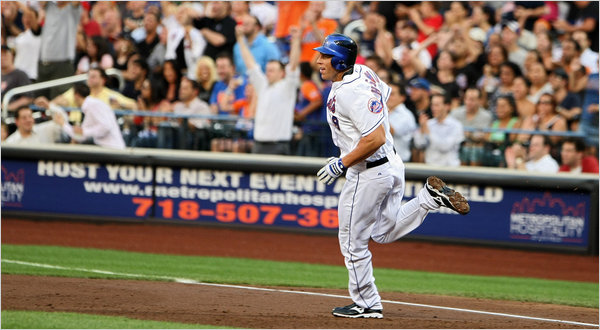
Mike Hessman made it to the Majors. He reached the pinacle of baseball. (Chang W. Lee/ The New York Times)
Mike Hessman is part of what makes baseball great. Effort and dedication allowed Hessman to create a 20-year professional baseball career (19 seasons in the Minors and Majors and one in Japan). It takes dedication and desire to spend 13 seasons just a step away from reaching your goal and only getting a few tastes of it. No one could have faulted Hessman if he decided to walk away after the 2011 season. Hessman had played 32 games for the Mets in 2010 and then went to Japan to play for the Orix Buffaloes in 2011. He had a good career but not many teams were looking to sign a 34-year-old Minor Leaguer.
Mike Hessman kept playing the game he loves. His years playing on the diamond allowed him to mentor countless young players whom he would see move on to the Majors while he remained behind. Mike Hessman got the most out of his abilities on the baseball diamond. His accomplishments might have occurred just short of the highest level of baseball in the world, but this does not diminish his accomplishments. Baseball demands the best effort from every player who steps on the field. The majority of people see their best efforts peak playing in the sandlot or in high school. A small minority of us may play baseball in college, play independent baseball, or get drafted. An even smaller minority makes it to the higher tiers of the Minor Leagues. Only a gifted few make it all the way to the Major Leagues. Even then, only a small pittance of those players are fortunate enough to have a long and successful career.
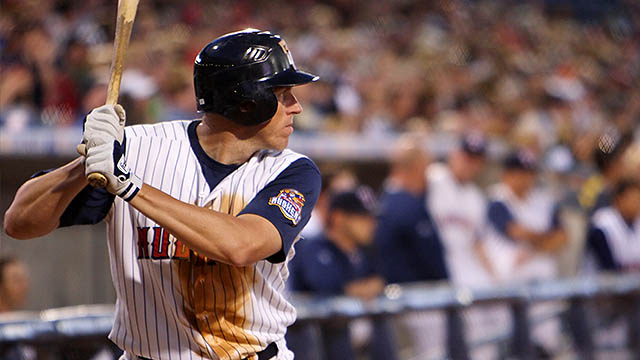
Mike Hessman finished his historic career with the Toledo Mud Hens. (www.MiLB.com)
Mike Hessman accomplished things that nearly none of us even will. He played baseball professionally for 20 years. Almost all of us would love to be so lucky. He made it to the Major Leagues and was able to fulfill the dream held by nearly everyone as a child. Mike Hessman lived the dream for 20 years, even if that dream was a little different than he had originally imagined. Hessman has said he wants to coach baseball now that he has retired as a player. The Detroit Tigers were smart in hiring Hessman to be the hitting coach for their Class A team, the Connecticut Tigers. Any team who wanted to sign him would be making a smart decision. No one could have any doubt about whether Hessman would give up on a player. Often in life, the easiest person to give up on is yourself. Mike Hessman has proven he believes in himself and does not know how to give up. There is nothing minor about that.
DJ

